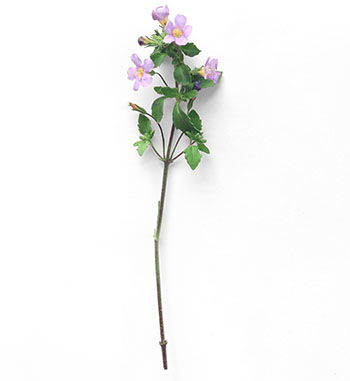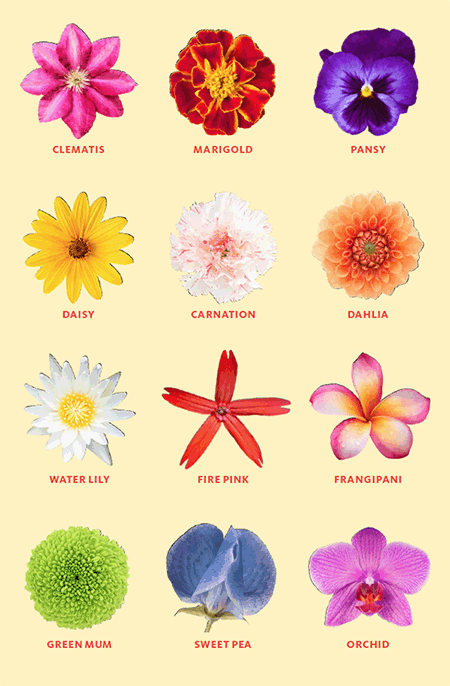Flowers—Not Just a Pretty Face
Flowers aren’t just pretty trinkets we enjoy for a moment. They’re among the most remarkable structures in nature.
Each spring, colorful gems begin popping up through the dark soil around my Arkansas home—I’m not just referring to the pearly pink tulips in my garden, but the sparkling trove of rainbow jewels in the wild. In my yard, yellow daffodils lift their faces to the sun. In a nearby meadow, striped violet Johnny-jump-ups in shades of amethyst appear, seemingly overnight.
The display follows a similar order annually. Dandelions and clover add sparkle among the emerald fields of petal-less Bermuda and Kentucky bluegrass. Soon afterward, dogwoods display their latest batch of white blossoms. By midsummer the exhibit dazzles with a profusion of lilies, marigolds, and lavender that appear behind my house.
Later, the purple, burgundy, and orange hues of sweet-smelling asters and chrysanthemums herald the arrival of autumn. And right before the world’s floral life goes dormant again, the holly tree’s tiny white blooms produce their familiar red berries, while ruby poinsettias arrive at the supermarket just in time to close another year.
This succession of visual and aromatic splendor far surpasses any man-made wonder you’ll find on the banquet tables of palaces or within the inner sanctum of temples. It’s as if some great King in heaven wanted to fill his earthly court with lavish reminders of his own power and delight in beauty.
Scientists are fascinated by these biological wonders. Their studies reveal that flowers are much more than inanimate gems or sweet-smelling chemistry. They serve very practical purposes—reproduction and food provision—with an elegant “flower” system that requires infinitely complex machinery and programming. They are among the most remarkable structures in all of nature, whose origin, from an evolutionary perspective, is almost as difficult to explain as our own.
Central to Seed Bearing
I love flowers—not just because I study them in my work as a botanist. Each year as they transform the winter wasteland, they touch me on a personal level, bringing to mind fond memories of my grandmothers, who kept gardens and instilled in me a love of flowering plants. To me, the varied blooms are familiar friends that work together to bring glory to God.
My Creator is practical and hardworking. He made the heavens and earth, and he calls his creations to continue that work. Flowers answer this mandate through fulfilling their wonderful underlying purpose—seed making.

Flower in the crannied wall,
I pluck you out of the crannies,
I hold you here, root and all, in my hand,
Little flower—but if I could understand
What you are, root and all, and all in all,
I should know what God and man is.
Alfred, Lord Tennyson, 1863
Blossoms are the reproductive centers of the angiosperms, or “flowering plants.” This group, so different from all other plants, produces not just striking blossoms but also the rarely noticed flowers on grasses and the homely flowers of trees like the hickory and oak, as well as those on plants submerged in streams or our aquariums.
The technical term for this whole class of plants, angiosperms, is based not on the flower, but on the type of seed it produces. Angiosperm comes from the Greek words angeion, meaning “case” or “casing,” and sperma, meaning “seed.” Another group of seed plants, gymnosperms, which includes pine trees and other conifers, produces naked seeds without a fruit container. Flowering plants always wrap their seeds within a fruit enclosure—whether that wrapping is a juicy blueberry or the hard, striped husk of a sunflower snack. No matter what form this fruit takes, manufacturing it requires a complex reproductive process. That’s where the flower comes in.
To see why “flowering” is such an unbelievably complex system, where God put all the working parts in place from the beginning, consider the apple tree. The flowers come in clusters of soft pink blossoms, called inflorescences. Within each flower are organs called stamens that produce pollen, which then makes male sperm. Each flower also contains one (or more) female-producing part, referred to as the carpel, which has a slender tube leading down to an egg-filled ovary within the flower’s base. We don’t usually think of flowers’ reproduction as being as complicated as that of the birds and the bees, but the egg and pollen—containing the sperm—must come into contact to produce any offspring (in this case, an apple).
But that’s a challenge. It requires outside help from an insect, like a worker honeybee. Through a complex chemical process, the flower produces nectar (the principle raw material of honey) to draw worker bees, who arrive at the tree and visit several blossoms. As the insects gather food from each flower, they transfer pollen to the carpel tips of other blossoms. The pollen then grows a threadlike extension down into the flower’s ovary, where the sperm fertilizes an egg and begins the seed-growing process.
At the moment of fertilization, wonderful changes begin to take place in the flower.
At the moment of fertilization, wonderful changes begin to take place in the flower. Like an expectant womb, the carpels slowly enlarge to accommodate the developing seeds. Meanwhile, the surrounding material begins to transform into the fleshy apple. At the same time, the petals shrivel and fall away—leaving behind only the stringy bits of flower you see at the base of your Red Delicious. All through the process, the parent tree sacrificially transfers its own food and energy directly to the new and growing seed to help it get off to a strong start. It also supplies resources to build the fruit around the seed, which is designed to attract and nourish the creatures that consume the apple so its seeds can find new homes.
The Bible assures us this fascinating, complex process has been in play since the beginning. God says in Genesis 1:11, “Let the earth sprout vegetation, plants yielding seed, and fruit trees bearing fruit in which is their seed, each according to its kind.” The Creator designed flowering plants to work hard in Eden from their start.
Incredibly Interconnected
Did you notice that fruit is only a secondary by-product of producing the next generation of plants, yet fruit is specifically intended to nurture animals? How like God to create a system for plants that blesses animals and humans too!
Since flower production was meant to involve various creatures, it’s no surprise God made the animals a couple of days after he made plants. This tells us two wonderful things. First, God acts step-by-step, or “decently and in order” (1 Corinthians 14:40). Second, our Creator values plant/animal relationships, just as he values relationships with and among his human creations.
Consider just one phenomenal example which involves my favorite pollinator, the hummingbird. The standing cypress produces a vivid red flower that appeals to the color vision of birds—particularly to the hummingbird’s.
Its sweet scent serves as an additional lure. Meanwhile, nectaries deep within the flowers produce nectar hummingbirds need. While the hummingbird happily flits from bloom to bloom, it transfers the pollen necessary to the plant’s future. The flowering world is full of these kinds of complex symbiotic partnerships.
God designed infinite variations that allow various plants to produce flowers all year long.
This general rule has a few exceptions, which emphasize the point by their exceptionality. Some plants—usually those with atypically small or closed flowers—self-pollinate. This is called autogamy. Others, such as grasses and many hardwood trees, count on the wind to spread their pollen (anemophily). (Flowers dependent on anemophily usually do not have petals.) Some plants, mainly aquatic seagrasses, rely on water to distribute pollen (hydrophily). But most angiosperms—through color, scent, ultraviolet markings, and even mimicry— are designed to attract insects or vertebrates to complete their own pollination.
Thankfully, flowering isn’t a one-size-fits-all process. God didn’t just design one unique process; he designed infinite variations that allow various plants to produce flowers all year long, in all shapes and sizes for all sorts of creatures.
Food for Thought
If you’ve ever thought flowers don’t belong in grocery stores, remember that we owe all this bounty to them. Blossoms are the factories that manufacture pears, cherries, almonds, coconuts, grapefruit, lemons, and indeed virtually all plant-based food. The grass family (Poaceae), for instance, gives the world wheat, rice, and barley. The legume family (Fabaceae) produces beans and peas. The nightshade family (Solanaceae) blesses our palates with potatoes, peppers, and tomatoes. Melons, cucumbers, and squashes come from the gourd family (Cucurbitaceae).
Without flowers, the world would suffer disastrous malnutrition. And without their hard work, we couldn’t enjoy popcorn with our movies, peppercorn on our steaks, vanilla in our ice cream, poppy seeds in our muffins, or saffron in our yellow rice.
Yet flowers do more than please our eyes, tongues, and noses. They are indirectly responsible for raw materials that clothe and house us, like cotton, flax, and wood. Behind every lumberyard and every blue jean manufacturer is, in fact, a flowering plant.
Blooms also play key roles in producing many medicines that help us in this now-fallen world. For example, aspirin comes from the bark of the willow tree. Drinking a tea of steeped blooms of the hyssop, mentioned in Scripture, can manage arthritis pain. Digitalin, a well-known drug to treat congestive heart failure, comes from the foxglove plant, but even its flowers produce a compound used in the fight against cancer.
Spring is the time of year when nature wears a crown of glittering, functional color that our Creator designed. He did it with our good and pleasure in mind. So in the weeks ahead, whether you are driving down the road to work or sprucing up the yard after last winter’s chill, allow your eyes to ponder the flowers.
While you’re at it, harvest (or purchase) a bouquet and send it to someone who needs a smile. Tell them about the God who made these unique creations, which can only be attributed to the majestic craftsmanship of a loving King in heaven who wants to share his overflowing love and provision with all of us. The Savior gave mankind blossoms as just one more incentive to “be glad and rejoice, for the Lord has done great things!” (Joel 2:21).
Endless Variety
The variety of scent, size, and color just adds to our wonder at God’s unique design of flowering plants.
Such incredible variety suggests the Creator intended to make the land overflow with diverse plant life to benefit all creatures, in much the same way that he made the sea “teem” with all types of fish. We don’t know exactly what kind of diversity was on display among flowering plants in the garden of Eden or in the world before the flood, but we know that God designed within plant genes the potential for vast, preprogrammed diversification—that is to say, room for variety within the original created “kinds.” (28,000 species of orchids alone have been recorded.)
Formal classification research reveals between 270 and 400 distinct flowering plant families, and biologists place the number of recorded species at a whopping 250,000. This shows that God endowed flowering plants with genes that have helped them adapt to all the climate upheavals of earth’s history. Such lavishness and thorough planning make us say with the psalmist, “O Lord, how manifold are your works! In wisdom have you made them all” (Psalm 104:24).
Infrared to Ultraviolet
Flowers’ colors span the spectrum. A look at their diversity begins with white blooms, which are common, particularly among strongly scented flowers that rely on nocturnal creatures like moths, bats, and opossums for pollination.
Flowers fill the rainbow, from red to violet (shown above), and even into infrared and ultraviolet, which attracts bees and other insects that can see and pollinate them. More than just vivid individual colors, the beauty of flowers comes from their highly varied shapes and striking markings, such as stripes, dots, and spots.
Fragrant to Fetid
We usually think of flowers as fragrant, and many are. But they run the gamut. Some reek of decaying flesh—that’s to draw the flies and beetles which help pollinate them. Between these extremes are lemony, peppery, and minty fragrances, along with those that are beyond the detection of the human nose.
Answers Magazine
May–June 2018
All our lives we’ve heard that caves form slowly, over tens of thousands of years. But recent discoveries are turning old assumptions upside down.
Browse Issue SubscribeRecommended Resources

Answers in Genesis is an apologetics ministry, dedicated to helping Christians defend their faith and proclaim the good news of Jesus Christ.
- Customer Service 800.778.3390
- © 2024 Answers in Genesis







